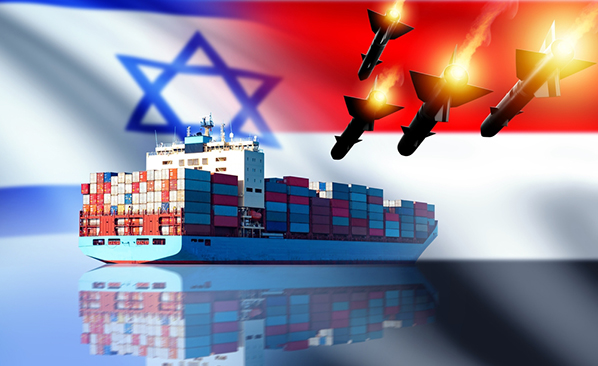
The dramatic escalation between Israel and Iran has sidelined the most significant disruption of global energy trade over the last year. Since mid-November 2023, the Houthi have launched dozens of attacks to commercial vessels, firing missiles and drones towards ships transiting the Red Sea, the Bab el-Mandeb Strait and surrounding areas. They also aimed multiple times at Israel’s territory, including during the night of April 13th, along with Teheran’s barrage.
However, the Yemenis Islamist group is much more than just a proxy of Iran. The cunning strategy adopted to target vessels has led the West, and particularly Europe, to realise the conspicuous threat represented by disruptions to energy flows in vital chokepoints. Around 15% of global trade passes through the Red Sea and the Suez Canal handles 12% of world trade. A great share of this volume consists of crude, oil products and liquefied natural gas (LNG). But, how a die-hard faction of a ten-year Civil War has in fact re-shaped energy geopolitics in a matter of just a few weeks?
Controlling only a portion of Yemen, the Houthi have been able to resist a Saudi- and UAE (United Arab Emirates)-led coalition in a prolonged war causing one of the worst humanitarian crises in recent history. Encroaching into Western Yemen and in a perfect position to oversee the maritime traffic through the Suez Canal and the Bab el-Mandeb Strait, Houthis have launched their challenge to the liberal world order resting on the free flows of goods.
Taking the Red Sea as their stage, the rebels are formally acting in support of the Palestinian cause. Nonetheless, they are de facto expanding their control over the adjacent maritime zones. From the capital Sanaa, the faction has issued a formal ban of all vessels linked to Israel, but also the US and UK. This has further bolstered their legitimacy at home, while displaying themselves as a heroic resistance movement to an Arab world frustrated by the lack of solutions to the Gaza mayhem.
Undeterred by sanctions, the positioning of Western fleets just miles off Yemen’s shores and multiple airstrikes, the Houthi are playing a leading role in reshaping global energy geopolitics.
This is nothing new. Back in 2019, Houthi’s UAVs (Unmanned Aerial Vehicles) and missiles struck Saudi’s major oil upstream and processing facilities. Riyadh was forced to curtail more than 50% of its oil production, equal to 5% of global supply. Markets reacted in shock. During the first full day of trading, Brent and WTI (West Texas Intermediate) skyrocketed, experiencing the largest single-day price increase in the decade up to 2019. Ultimately, the threats to Saudi oil production compelled Riyadh to re-think its strategy in Yemen and return to the negotiating table.
The Yemenis group leadership knows how to play energy geopolitics very well, deliberately tearing apart the vital corridor linking the Atlantic and the Indian basins. Constrained by regional geopolitics, Riyadh has refused to openly support the Western coalition airstrikes fearing further repercussions.
In the meantime, a plunge in journeys through that region has led crude, oil products and LNG tankers to divert voyages around Africa. In February 2024, oil tankers crossing the Red Sea were almost a half of those a year earlier. All major energy players adopted contingency plans. UK-headquartered energy giants BP and Shell, interrupted all shipments through the area, hoping this was just “a short-lived reality”.
Quite the contrary. Even QatarEnergy, the second-largest LNG exporter in the world has been forced to add at least 10 days for each single journey from the Persian Gulf to Europe through the Cape of Good Hope, and vice versa. This, even though Doha has been assisting the Houthis in its anti-Saudi strategic repositioning. Qatar is in the process of massively expanding LNG production and exports. And yet, since the Red Sea has become a war zone, no new long-term contract has been signed with European energy players, while TotalEnergies agreed to a 27-year deal with Qatar just a few days after October 7th. The longer tensions will persist, the more evident the distance separating Qatar from Europe will become. Even though Europe turned into the premium global LNG buyer, paying hefty prices for LNG imports in 2022 and 2023, the restricted marketing opportunities will force Doha to look to the East, at the Asian growing gas demand.
At the same time, the slick politicisation of global energy trade has granted the Islamic faction to deepen contacts with Moscow. Allowing the safe passage to Russia and China vessels, Houthis accessed the highest echelons of diplomatic support within the same United Nations Security Council.
With Russia’s oil and gas exports to the West reduced to peanuts compared to pre-Ukraine levels, Houthis actions have a multiplier effect on Europe’s energy crisis. The Mediterranean terminals, and particularly those in the East, became a periphery of global energy trade. Barred from accessing Suez, all these markets will continue to pay an unusual premium to secure LNG supplies. In the first three months and a half of 2024, shipments transiting from the Canal have been less than a quarter compared to the same period in 2023. Costlier gas will continue to weight on regional economies. Egypt, forced to import gas as a consequence of its dire energy strategy, could even become reliant on LNG coming from the US, instead of closer Middle Eastern suppliers like the UAE, among Houthis sworn enemies.
Since tensions escalated between Iran and Israel, European gas prices jumped, erasing this year’s losses and prompting traders to hedge against risks of a larger conflict in the Middle East. Luckily for Europe, a very mild winter ended leaving plenty of supplies in gas storages. Moreover, oil is abundant in the Atlantic Basin[1] and non-OPEC+ (Organisation of the Petroleum Exporting Countries) supply continues to grow. Yet, Houthi have plenty of opportunities to squander this tenuous balance, and for Iran to filter the maritime traffic through Suez.
Teheran’s stronghold on Hormuz could be perceived either as a phenomenal threat or a bravado.[2] However, with Houthis affecting the Red Sea and Suez scenarios, the Sanaa-Teheran axis has the real chance to reap the diplomatic and market benefits of having both hands around the vital energy chokepoints of the Middle East. Something that won’t be given away easily, even once the carnage in Gaza will be over.






